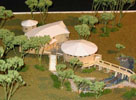| |
Cambodian land mine museum designs unveiled
 Students explore programming, planning, design
for unique educational facility
Students explore programming, planning, design
for unique educational facility
| |
|
Photographer Richard Fitoussi of Toronto, Canada, founder and CEO
of the Cambodian
Land Mine Museum Relief Fund (CLMMRF), invited Texas A&M University’s
College of Architecture students to undertake the programming, planning
and design of a proposed land mine museum prevention and rehabilitation
center for Siem Reap, Cambodia.
The students’ finalized designs and models for the museum were exhibited and presented to Fitoussi at a public final review staged Oct. 8 in the fourth-floor studio of the Langford Building at Texas A&M.
The invitation was extended because of the College of Architecture's reputation and proven track record in undertaking more than 450 “architecture for health” projects on a national and international level since the health design program was established in 1966, says George J. Mann, AIA the Ronald L. Skaggs Endowed Professor of Health Facilities Design.
Mann and Julie Rogers co-directed the project. Thirty-six second and third year students worked on the project and were advised by about 20 faculty members and 30 master’s and Ph.D. students. Rogers, who holds a doctorate and has traveled extensively throughout Southeast Asia studying art and architecture of the region, has visited the land mine museum in Cambodia that the CLMMRF is in the process of developing. She launched a first-year class project on the land mine museum three years ago, almost the same time that the CLMMRF was being created by Fitoussi. Rogers has a key role in providing research to the students about the current museum because she had been to Cambodia and understands the climate as well as the geographic and material restrictions of the country.
The CLMMRF initially sent a proposal to the College of Architecture this spring while researching potential institutions that might be interested in launching an initiative to design a facility capable of fulfilling the CLMMRF humanitarian goals. Mann, an international expert in the field of medical and health related architecture, was contacted because of his involvement with a land mine rehabilitation center that he had helped to design in Leon, Nicaragua together with Mercy Ships.
Fitoussi visited Texas A&M Sept. 8 to kick off the project and to meet the students. His mission is to help raise awareness and funding to transform an existing land mine museum in Siem Reap into a sustainable land mine museum, prevention and rehabilitation center. Later, the students had four hour-long conference calls with Fitoussi to listen to him respond to their design concepts.
Fitoussi has led the CLMMRF's photographic lecture series for more than three years. Much of the organization's funding has been raised through this awareness program. The presentation involves an extensive lecture accompanied by photojournalism that documents the nightmare of land mines in Cambodia. Some six to 10 million mines still remain scattered throughout the Cambodian countryside – almost one for each inhabitant.
Fitoussi's images capture life in post-Khmer Rouge Cambodia and illustrate the state of Khmer culture, both in rural and urban environments. His work is imbued with the emotional and physical devastation of the Pol Pot regime on Cambodia, but also highlights the spirit and perseverance of the Khmer people who have since moved forward to rebuild their shattered nation. Fitoussi's work has been exhibited along side some of the world's leading photographers including Robert Capa and American photographer James Nachtwey, as well as photographers from National Geographic and Rolling Stone Magazine.
To date, Fitoussi’s work has been seen by more than 50,000 people worldwide and has helped to raise more than $130,000 for the proposed project. His inspiration for his effort grows from his collaboration with Aki Ra, a Cambodian ex-child soldier who now curates the Cambodian Land Mine Museum in Siem Reap. Driven by contrition at his multiple conscriptions into various armies, during which he was forced to lay land mines himself, Aki Ra has dedicated his life to the removal of every remaining land mine from Cambodian soil.
Having cleared more than 10,000 mines single handedly with little more than simple tools, Aki has voluntarily helped to clear what might have cost nearly $3 million worth of de-mining. Aki and his land mine museum, prevention and rehabilitation center have been written about in almost every international press publication and he is the focus of more than 10 different documentary films from eight different countries.
| |


 Click images to enlarge.
Click images to enlarge. |
|
| |
|
|